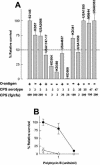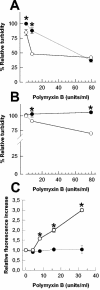Capsule polysaccharide mediates bacterial resistance to antimicrobial peptides
- PMID: 15557634
- PMCID: PMC529140
- DOI: 10.1128/IAI.72.12.7107-7114.2004
Capsule polysaccharide mediates bacterial resistance to antimicrobial peptides
Abstract
The innate immune system plays a critical role in the defense of areas exposed to microorganisms. There is an increasing body of evidence indicating that antimicrobial peptides and proteins (APs) are one of the most important weapons of this system and that they make up the protective front for the respiratory tract. On the other hand, it is known that pathogenic organisms have developed countermeasures to resist these agents such as reducing the net negative charge of the bacterial membranes. Here we report the characterization of a novel mechanism of resistance to APs that is dependent on the bacterial capsule polysaccharide (CPS). Klebsiella pneumoniae CPS mutant was more sensitive than the wild type to human neutrophil defensin 1, beta-defensin 1, lactoferrin, protamine sulfate, and polymyxin B. K. pneumoniae lipopolysaccharide O antigen did not play an important role in AP resistance, and CPS was the only factor conferring protection against polymyxin B in strains lacking O antigen. In addition, we found a significant correlation between the amount of CPS expressed by a given strain and the resistance to polymyxin B. We also showed that K. pneumoniae CPS mutant bound more polymyxin B than the wild-type strain with a concomitant increased in the self-promoted pathway. Taken together, our results suggest that CPS protects bacteria by limiting the interaction of APs with the surface. Finally, we report that K. pneumoniae increased the amount of CPS and upregulated cps transcription when grown in the presence of polymyxin B and lactoferrin.
Figures




References
-
- Agerberth, B., J. Grunewald, E. Castanos-Velez, B. Olsson, H. Jornvall, H. Wigzell, A. Eklund, and G. H. Gudmundsson. 1999. Antibacterial components in bronchoalveolar lavage fluid from healthy individuals and sarcoidosis patients. Am. J. Respir. Crit. Care Med. 160:283-290. - PubMed
Publication types
MeSH terms
Substances
LinkOut - more resources
Full Text Sources
Other Literature Sources
Miscellaneous

